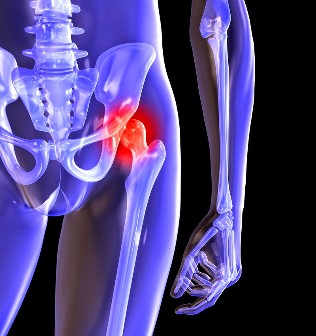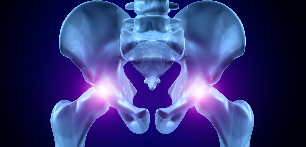Osteoarthritis of the hip joint — degenerative-dystrophic pathology, for by the destruction of the hyaline cartilage. The disease develops gradually, accompanied by sore syndrome and decreased mobility. If there is no medical Intervention in the early stages of osteoarthritis after a few years, the atrophy of the thigh muscles. Damaged limb is shortened, and the fusion of the joint space leads to a partial or complete paralysis of the hip joint. The causes of the pathology are injuries, spinal curvature, systemic diseases of the locomotor system.

Arthritis usually presents in patients of middle age and older people. The diagnosis is made on the basis of the results of instrumental studies, x — ray, MRI, CT, arthroscopy. Treatment of the pathology, 1, and 2 severity to be conservative. In the case of the detection of ankylosis or ineffectiveness of drug therapy, surgical Operation (arthrodesis, arthroplasty) is.
The mechanism of development of pathology
The hip joint, the two bones — the Ileum, and the upper thigh. The lower part of the Ilium is represented by his body, which is formed in the mesh of the Femur in the upper portion of the acetabulum. During the journey sustavnaya the Fossa, unable to move, legs and head free to move. Is hip to the "swivel" device-articulation allows him to bend, to relax, to turn, promotes the Association, reduction of the hip. The unhindered sliding of the joints of the structures offers a smooth, elastic, elastic cartilage-hyaline, the chamber recess and the head of the femur. Its most important functions — the redistribution of loads in the case of travel, warning, rapid wear of bone tissue.

Under the action of external or internal factors, trophic of the cartilage is disturbed. He has no own vascular system — the tissue supplied with nutrients by the synovial fluid. In the case of osteoarthritis it is thickened, is tough. The lack of nutrients provokes damage to the drying of the surface cartilage. It is covered with cracks, which leads to a continuous micro-injury of tissue during flexion or extension of the hip joint. Cartilage thin, lose its cushioning properties. To "adapt" to an increase in pressure, deformation of the bone. And on the background of the deterioration of the metabolism in the tissue to continue the destructive and degenerative changes below.
The causes and triggering factors
Idiopathic or primary osteoarthritis develops without any reasons. It is believed that the destruction of the cartilage tissue due to the natural aging process of the body, slowing down regenerative processes, lowering the production of collagen and other compounds, resulting in the complete Regeneration of the structures of the hip joint. Secondary osteoarthritis occurs against the background of the already existing pathological condition in the body. Among the most common reasons of secondary disease:
- injury — damage to the tendon of the apparatus, torn muscles, or their complete separation from the bone base, bone fractures, dislocations;
- Developmental disorders of the joints, congenital dysplastic diseases;
- autoimmune pathology of rheumatoid, reactive, psoriatic Arthritis, systemic Lupus erythematosus;
- non-specific inflammatory diseases, such as purulent Arthritis;
- specific infections — gonorrhoea (the clap), Syphilis, brucellosis, ureaplazmoz, Trichomoniasis, tuberculosis, Osteomyelitis, encephalitis;
- Dysfunction of the endocrine system;
- degenerative-degenerative pathology — osteochondropathy of the femoral head;
- Hyper mobility of the joints, due to the development of "Super stretchy" collagen stimulating their excessive mobility, weakness of the ligaments.
Since the cause of osteoarthritis hemarthrosis (bleeding into the cavity of the hip joint), then to trigger factors can be disorders of blood formation count. Prerequisites for the development of the disease are obesity, excessive physical strain, lack of exercise. To lead its development, improper organization of sports training, deficiency in the diet foods with a high content of trace elements, the Giro - and water-soluble vitamins. Postoperative arthrosis occurs a few years later after surgery, especially if it is accompanied by the excision of a large volume of tissue. Osteoarthritis of the hip joint can not be inherited. But if certain innate properties (metabolism, the structure of the skeleton) increases the likelihood of developing significantly.
Symptoms
Leading symptoms of osteoarthritis of the hip joint — pain in the knee articulation in the hip. A Person suffers from stiffness in movements, stiffness, especially in the morning hours. To limp in order to stabilize the connection, the Patient begins to change his gait. In the course of time due to muscle atrophy and deformation of the articulation of the limbs are significantly shortened. Another characteristic feature of the pathology — the limit of the derivatives of the hip. For example, difficulties in trying to sit down on the stool, the legs spread.

Also the "started" OSTEOARTHRITIS can be treated at home! Only do not forget, once a day, this lubricates...
In the case of osteoarthritis in the first degree is characterized by severe periodic pain after intensive physical loads. You are in the area of articulation and disappear after a longer holiday.
In the case of osteoarthritis, second-degree connections, the severity of the pain in the hip increases. Complaints occur even at rest, extend to the thighs and groin area, worse when lifting heavy or increased physical activity. To hobble to the elimination of pain in the hip joint, the person begins hardly noticeable. Limitation of movement in the joint celebrated, especially in the case of the abduction and internal Rotation of the thigh.
Osteoarthritis in the third degree is characterized by the constant strong pain. In the case of the movement difficulties arise, so that when walking, the person is forced, a cane or crutches. Due to the weakness of the discharge ends of the muscles thighs happens the displacement of the pelvic bone in the frontal plane. To compensate for the shortening of the incident of the sick feet in the movement leans in the direction of the injured limb. This provoked a strong shift of the center of gravity and an increase in the loads on the joint. In this stage of osteoarthritis, a pronounced ankylosis of the joint develops.
| Degree | Radiological Signs |
| The first | The changes are not pronounced and sharp. Joint-gap moderate, unevenly narrowed, no destruction of the surface of the femur. On the outer or inner edge of the Acetabulum smaller bony observed growths |
| The second | Height of the joint gap is considerably reduced because of its uneven adhesions. The bony head is offset from the hips up, distorted, enlarged, its edges jagged. Bone growths formed on the surface of the inner and outer edges of the socket |
| The Third | There is a full or partial merger of the joint-gap. Femoral head greatly expanded. Multiple bony growths on all surfaces of the acetabulum |
Diagnosis
In the case of the placement of the diagnosis of the doctor, the clinical symptoms of the pathology, medical history, results of the external audit, Patient and instrumental studies. The most informative radiography. With your help, evaluated the condition of the hip joint, is the Phase in its history, the extent of the damage to the cartilaginous tissue, and in some cases, the cause of development. When the cervico-diaphyseal nodes increases, and the Acetabulum is beveled and flattened, then with great probability it can be. of which congenital out dysplastic changes of articulation On the Morbus Perthes, the broken Form of the bones of the upper thigh shows. X-ray, we post-traumatic osteoarthritis can be injury, even though no history of previous disease. Used other diagnostic methods:
- CT can help you find the urban sprawl of the edges of the bony plates, the osteophytes;
- The MRI is used to assess the state of the connective tissue structures and the degree of their involvement in the pathological process.
If necessary, the inner surface of the joint is measured with the help of arthroscopic instruments. Differential diagnosis is performed for the exclusion of osteoarthritis of the knee, lumbosacral or thoracic osteochondrosis. Pain in osteoarthritis can be caused by the masquerade as clinical symptoms arrangement of the edge-syndrome, entrapment or inflammation of the nerve. To exclude neurogenic pathology can usually through a series of Tests. Osteoarthritis of the hip joint necessarily differentiated from the top of the Bursitis of the hip, ankylosing spondylitis, reactive Arthritis. For the exclusion of auto-immune pathologies are biochemical studies of blood and synovial fluid.
Surgical Procedures
With the ineffectiveness of conservative therapy Schlick difficult diagnosis of the pathology, the surgery is performed. Cartilage repair in the joint, osteoarthritis of the injured party, without the Operation of physiognomy impossible, but with the right approach to treatment, compliance with all medical prescriptions, the leadership of the right way of life, occupations, physical therapy, regular courses of Massage, the intake of vitamins and proper nutrition can stop the process of the defeat and destruction of the cartilage and hip joints.

































